I KNOW ,I KNOW IS A COPY AND POST BUT I CAN NOT STOP TO COPY AND POST THAT
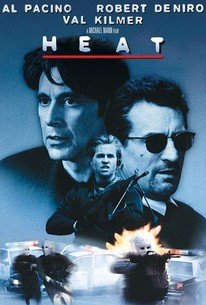
Heat: how Michael Mann made his coolest film FEATURE
Robert De Niro and Val Kilmer in Michael Mann's crime-drama 'Heat'
Al Pacino and Robert De Niro face off in Michael Mann's 'Heat'
Credit: Rex Features
0
PX*5684147
Robbie Collin
19 February 2015 • 11:21am
Twenty years after it was made, Michael Mann's showdown between two Hollywood heavyweights burns as brightly as ever
The Kate Mantilini restaurant in Beverly Hills is closed now, a squat, storm-grey fragment of Eighties Los Angeles flanked by brand-new, sand-white apartments and office blocks. But while the place was still open, you could go in and ask to sit at The Table, and the staff knew exactly where to take you.
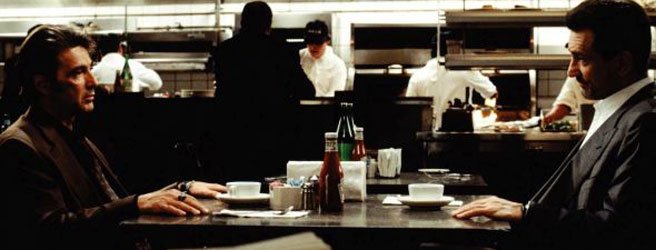
The Table was where Al Pacino and Robert De Niro sat opposite one another in early 1995 to shoot the first of their two scenes together in Heat, the latest film from Michael Mann. It was a showdown cinemagoers had been anticipating since at least 1974, when The Godfather: Part II had marked out both actors as heirs to, and perhaps even reincarnations of, Marlon Brando.
De Niro had played the young Vito Corleone, the role Brando had made iconic in the first Godfather film, while Pacino returned as Vito’s youngest son Michael, heir to the Corleone crime family. 
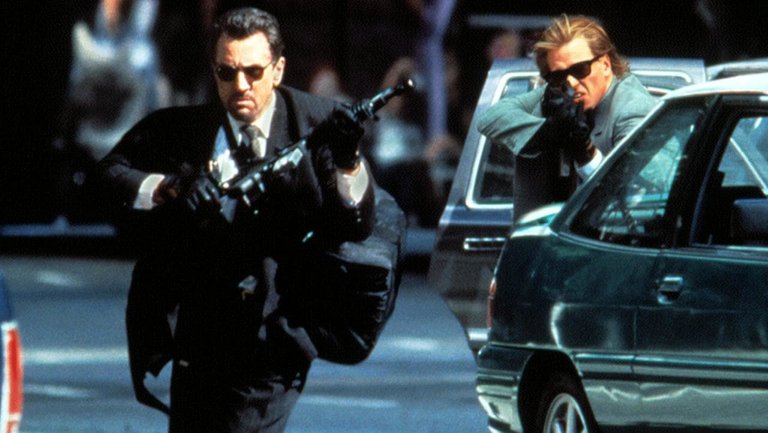
Squeezing both into the same film had been exciting enough, even though they’d never shared a scene. But De Niro and Pacino going head to head, in the very same shot? This was going to be special.
The Warner Bros. marketing department made sure we knew it. “Now, for the first time, America’s two most electrifying actors collide!” promised the trailer for Heat. But that night in Kate Mantilini, it wasn’t clear that much colliding was taking place. Their characters just looked like two regular guys talking over coffee.
Al Pacino and Robert De Niro face off in Michael Mann's 'Heat'
Al Pacino and Robert De Niro face off in Michael Mann's 'Heat'
Credit: Rex Features
Of course, Vincent Hanna (Pacino) and Neil McCauley (De Niro) are about as regular as sabre-toothed tigers. The former is a Los Angeles robbery-homicide detective, the latter the most talented thief he’s ever come up against.
The fact that these two actors were “just talking” – not even shouting at each other, for goodness sake! – feels at first like a devastating anticlimax. But because this muted timeout session allows Hanna and McCauley a once-in-a-lifetime chance to speak plainly with one another, it brings the film’s grand themes of crumbling masculinity and moral destiny slamming into focus.
It also allows McCauley to set out the personal code that will come to define his own fate. “A guy told me one time: 'Don’t let yourself get attached to anything you are not willing to walk out on in 30 seconds flat if you feel the heat around the corner’,” he says.
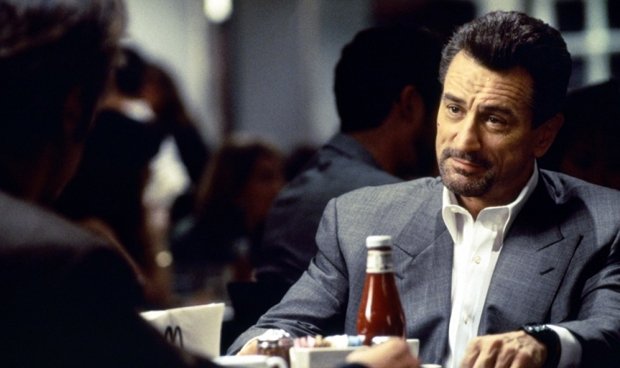
Hanna, whose third marriage is on the brink of collapse, expresses surprise that McCauley could leave his lover without saying so much as goodbye. McCauley shrugs. “That’s the discipline,” he replies.
The scene was supposed to be shot halfway through Heat’s production, but De Niro asked for it to be brought forward and filmed cold, without rehearsal. Mann agreed: he knew what was riding on the scene, and also knew that the chemistry between these two bombastic actors would probably only ever be right once or twice.
Dante Spinotti, the cinematographer, set up two cameras, one angled over each actor’s shoulder, and had both turning over at once while Pacino and De Niro ran the scene again and again. Most of what we see in the film is from the 11th take.
Al Pacino and Robert De Niro in the restaurant scene from 'Heat'
Al Pacino and Robert De Niro in the restaurant scene from 'Heat'
Credit: Moviestore Collection/REX
Spinotti’s camera placement is vital to the scene’s effect. On the day he tried a few more set-ups, shooting both men from the side and also from directly above – far more aggressive compositions, which placed De Niro and Pacino as opposing forces, staring each other down from either side of the screen. But that footage was never used. At this point in Heat, we’re not supposed to see the characters as arch-enemies, but slightly skewed reflections of one another – or perhaps opposite sides of the same, well-thumbed coin.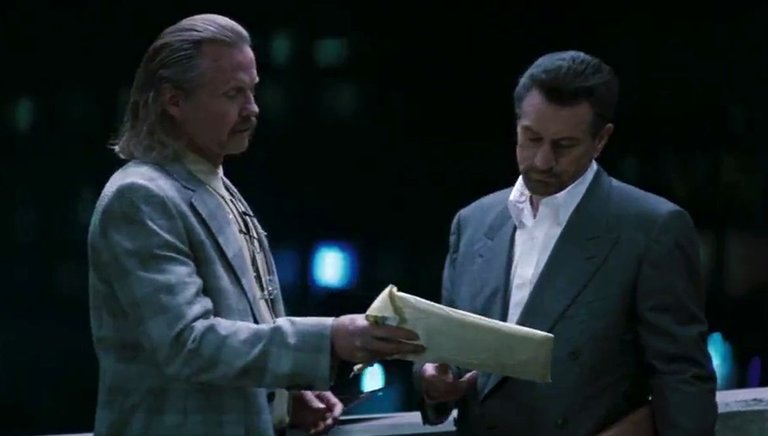
The fact that both cameras were rolling at once means we can see the two actors echo one another’s movements. A slight cock of the head by Pacino is repeated by De Niro seconds later, while a subtly raised eyebrow travels in the opposite direction. At the very end of the scene, when McCauley suggests the two men might not see each other again, he gives a tiny, almost unreadable smile, which bounces to Pacino and then bounces back, a little bigger.
Before this, we’ve watched these two men struggle to make a meaningful connection with anyone else in the entire film. Hanna freely admits his personal life is a “disaster zone”, while McCauley lives in a sparsely furnished apartment on the coast: like his house, he’s mostly empty on the inside, the upshot of his 30‑second rule.
In a memorable early sequence, McCauley returns home, rests his gun on a glass coffee table and stares out to sea. Mann closely modelled the scene on Pacific, an Alex Colville painting from 1967, recreating Colville’s plaintive tableau almost exactly before dousing it in blue light. (In Heat, all of Los Angeles glows blue at night – the pale, enticing blue of an electric bug zapper.) But here, the two men find in each other a kindred spirit.
Al Pacino in Michael Mann's crime-drama 'Heat'
Al Pacino in Michael Mann's crime-drama 'Heat'
Credit: Rex Features
Pacino and De Niro were Mann’s first choices for the lead roles in Heat, and it’s impossible to imagine the film working with anyone else. (At one stage, Jeff Bridges and Nick Nolte were considered as a backup plan.) But there’s a certain cold-hearted genius in casting them that goes deeper than just setting up a showdown between two screen legends.
At this stage in their respective careers, both men weren’t so much at the peak of their powers as at the point at which their powers were starting to overwhelm them. For the characters and stars alike, this was potentially their last big score. And Pacino and De Niro’s only other collaboration to date, the dreadful 2008 cop thriller Righteous Kill, would suggest that what Mann achieved in Heat was unrepeatable.
Mann chose his moment well. He’d been sitting on the script for Heat since the early Eighties and had already made a bastardised small-screen version, LA Takedown, while working in television. The whole plot had grown outwards from the diner scene, which – astonishingly – was based a true story.
While he was working on the television series Crime Story and Miami Vice, Mann met Chuck Adamson, a Chicago cop turned screenwriter who had been fascinated during his time as a serving officer by a ruthless, meticulous, enterprising professional thief called Neil McCauley.
Adamson had known the real McCauley couldn’t be reformed – he was too good at what he did – so one day in 1963, he asked him out for coffee and the two men had a frank and civil conversation that ran almost identically to the Heat diner scene. Adamson warned McCauley that the next time they met, one of them would probably kill the other, and sure enough, the following year, the cop shot the thief dead during a thwarted supermarket robbery.
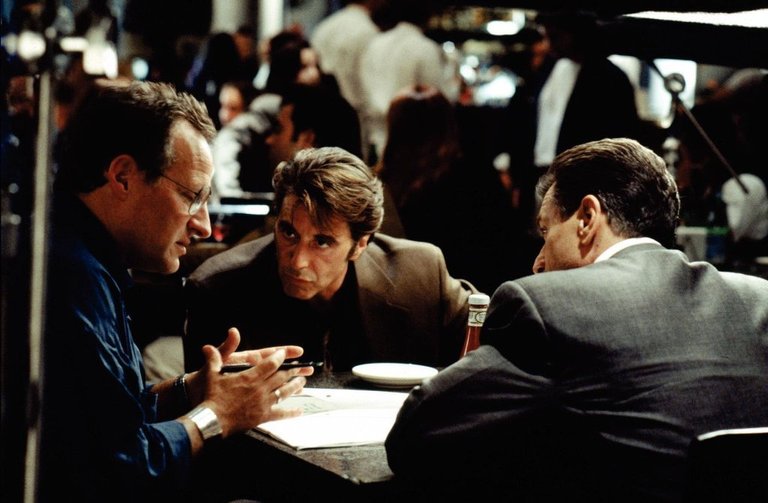
In the film, the final showdown between Hanna and McCauley is saved for later and the robbery is relocated to a bank. The resulting heist scene is one of the greatest action sequences ever made: a skin-pricklingly tense set piece of expert thieves at work which then seamlessly slips into a scene of terrifying chaos.
McCauley begins the robbery by telling the customers: “We’re here for the bank’s money, not your money. Your money’s insured by the federal government, you’re not going to lose a dime.” He’s modelling himself after the folk-hero bank robbers of the Thirties, and in fact Mann liked the line so much, 14 years later he gave a more mumbled version of it to Johnny Depp’s John Dillinger in Public Enemies.
The anxious, thrumming music is Force Marker by Brian Eno, a piece that’s inspired countless tense action soundtracks since, not least of all Hans Zimmer and James Newton Howard’s work for the similar bank heist at the start of The Dark Knight, which is virtually a cover version.
The heist itself goes smoothly, but just as the last robber, Val Kilmer’s Chris Sheherlis, reaches the getaway car, the police arrive. Without pausing, Kilmer smiles, aims his carbine rifle at the cops on the other side of the road and pulls the trigger, and World War Three breaks loose.
Bystanders have rarely felt more vulnerable in a shoot-out than they do here. That’s partly because of the way Mann stages the scene, not allowing us to think for a second that a single square foot of the street is safe. But it’s also because of the noise of the gunfire itself, which sounds like the sky is being torn apart like a sheet.
Normally, any gunshots we hear in a film are sound effects added during the editing process. But Mann stuck with the din of the blank rounds his cast were firing on location because of the way it filled the empty Los Angeles air – and then stayed there, bouncing between buildings, ringing in our ears and jangling our nerves.
It’s of a piece with a film that’s at once mythic and realistic, thrilling and sobering, all style and all substance in a way that perhaps only Mann could have pulled off. Heat makes some outlandish rules for itself but then sticks to them coldly and scrupulously.
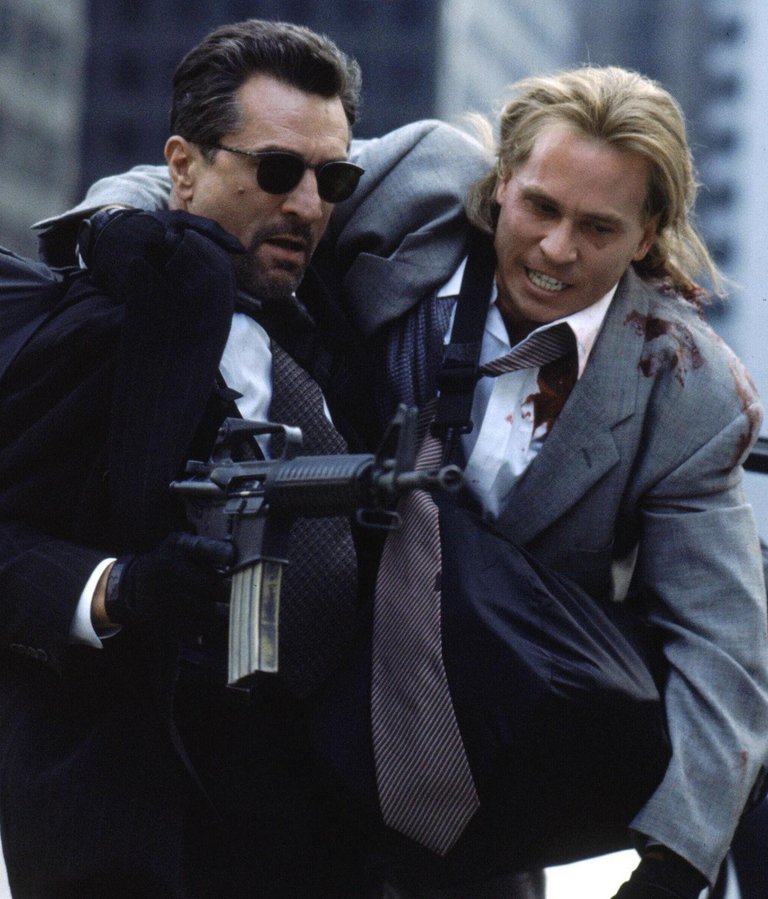
Next time you watch it, have a stopwatch handy for the scene towards the end in which McCauley leaves the airport hotel to make his escape with Eady (Amy Brenneman), his young love, and then realises Hanna is on his tail.
Start it running at the moment McCauley becomes fully aware of the gravity of the situation. De Niro rocks backwards on his feet slightly, as if the realisation has physically brushed past him. Then stop it as soon as he’s glanced back at Eady for the last time before disappearing into the crowd. I made it 29.8 seconds exactly. That’s the discipline
HOPE ENJOY
juansurf67
Congratulations @juansurf67! You have completed some achievement on Steemit and have been rewarded with new badge(s) :
Click on any badge to view your own Board of Honor on SteemitBoard.
For more information about SteemitBoard, click here
If you no longer want to receive notifications, reply to this comment with the word
STOPHi! I am a robot. I just upvoted you! I found similar content that readers might be interested in:
http://www.telegraph.co.uk/film/blackhat/pacino-deniro-making-of-heat/
Congratulations @juansurf67! You have completed some achievement on Steemit and have been rewarded with new badge(s) :
Click on any badge to view your own Board of Honor on SteemitBoard.
For more information about SteemitBoard, click here
If you no longer want to receive notifications, reply to this comment with the word
STOP